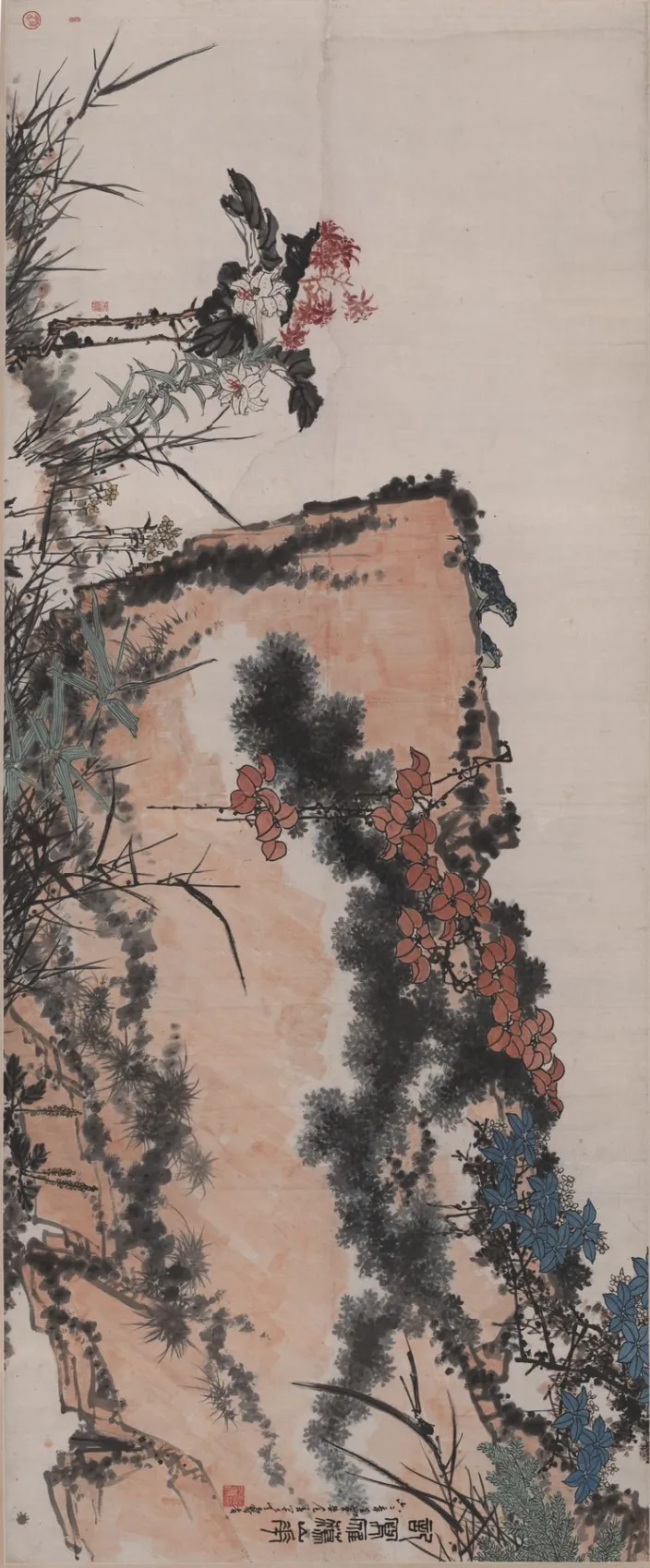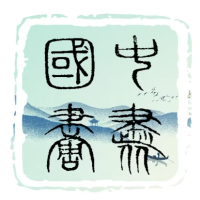潘天寿,字大颐,号阿寿、寿者,浙之宁海人也。生于丁酉年三月十四日(1897年3月14日),殁于辛亥年八月初八日(1971年9月5日)。少承庭训,父潘秉璋为秀才,乡长多年,精于书法。母周氏多才,擅剪纸。耳濡目染,遂启艺道。乙卯年(1915年),入浙省立师范,师经亨颐、李叔同。初学吴昌硕,后取法石涛、八大山人。癸亥年(1923年),谒吴昌硕于沪,艺益精。
Pan Tianshou, styled Dayi, also known as Ashou and Shouzhe, was a native of Ninghai, Zhejiang. Born on March 14, 1897 (Dingyou year), he passed away on September 5, 1971 (Xinhai year). From a young age, he received family education. His father, Pan Bingzhang, was a scholar and a village head for many years, skilled in calligraphy. His mother, Madam Zhou, was talented and excelled in paper cutting. Influenced by his parents, Pan Tianshou developed an early interest in art. In 1915 (Yimao year), he entered the Zhejiang Provincial Normal School, studying under Jing Hengyi and Li Shutong. Initially, he learned from Wu Changshuo and later drew inspiration from Shitao and Bada Shanren. In 1923 (Guihai year), he visited Wu Changshuo in Shanghai, further refining his artistic skills.

潘天寿先生谓中国画重意境,画中诗境,诗中画意,乃诗画创作高标。其国画笔墨强劲霸悍,造型沉雄,立意、形态、骨气凝于笔端。画风曰:“天惊地怪见落笔”,此天寿独特风格也。潘天寿艺贵大胆创新,常曰:“常中求变以悟常,变中求常以悟变”。其画作多指墨,指蘸墨作画,大幅之作,四指并下,气势磅礴,恢弘壮阔。题材有鹰、荷、松、四君子、山水、人物,每作奇布局,险中求平,形简意远,含天地人文之大道。
Pan Tianshou believed that Chinese painting emphasizes artistic conception, integrating poetic ambiance in painting and seeking pictorial elements in poetry, setting a high standard for poetic and pictorial creation. His Chinese paintings are characterized by powerful and vigorous brushstrokes, robust and majestic forms, with the essence, shape, and spirit condensed at the tip of the brush. His painting style is described as "heaven-shaking and earth-shocking with every stroke," showcasing his unique approach. Pan Tianshou valued bold innovation in art and often said, "Seek change within the constant to understand constancy; seek constancy within change to understand change." Many of his works involve finger painting, where he dipped his fingers in ink to create large-scale paintings using all four fingers. This technique produced grand and powerful effects. His subjects include eagles, lotuses, pines, the Four Gentlemen (plum, orchid, bamboo, chrysanthemum), landscapes, and figures, each with a unique layout, balancing danger and stability, simplifying form while conveying profound meaning, embodying the great principles of nature and humanity.

















潘天寿画作,少见雍容牡丹,亦罕梅兰竹菊之君子题材。其多结合野草闲花,成独特风格。题材拓展,将花草与自然紧密相连,表达宇宙生机。结合野草野花,推动花鸟画向新题材、新视野发展,延绘画生命力。构图章法,二十世纪诸画家中独具一格,经得起推敲琢磨。不似他人简贴标签,实入自然,感时代气象。
In Pan Tianshou's works, luxurious peonies are rarely seen, nor are the traditional subjects of the Four Gentlemen (plum, orchid, bamboo, chrysanthemum). Instead, he often incorporated wild grasses and flowers, creating a unique style. He expanded his themes by closely connecting flowers and plants with nature, expressing the vibrant life of the universe. By incorporating wild grasses and flowers, he pushed traditional flower-and-bird painting towards new themes and perspectives, extending the vitality of his art. His composition and structure were unique among 20th-century painters, standing up to scrutiny and reflection. Unlike others who simply labeled their works, he genuinely immersed himself in nature, capturing the spirit of the times.
潘天寿谓西欧与东方地域异,人种殊,风俗各别。西人谓自然无墨,中国画以墨写物。古彩陶用墨,吴昌硕以墨红画牡丹,墨效尽显,色变复杂,对比强烈,臻于极致。
Pan Tianshou observed that the regions of Western Europe and the East differ, as do their peoples, customs, and habits. Westerners believed there was no ink in nature, but Chinese painting used ink to depict subjects. Ancient Chinese pottery used ink, and Wu Changshuo often painted peonies with ink and red, maximizing the effect of ink, creating complex color changes and strong contrasts, reaching perfection.
齐白石云:“妙在似与不似之间”,求神似,不求形似,此传统艺术之旨。墨为五色主,须白相配乃明。老子曰:“知白守黑。”画以笔取气,以墨取韵,焦、积、破取厚重。米襄阳已明此理。用墨之难,在枯、焦、润、湿之变。须枯焦而华滋,润湿而不漫漶,斯得其要。墨非水不活,笔非运不透,活则清神,运则化滞,二者不可偏废。色易艳,难古雅;墨易古雅,不流俗。以墨配色,济用色之难。水墨浓淡宜,黑白相用,干湿相成,百彩纷呈,虽无色,胜有色。五色自现,胜青黄朱紫。淡色求清逸,重彩求古厚,知此得用色极境。
Qi Baishi said, "The charm lies between likeness and unlikeness," aiming for spiritual resemblance rather than mere physical likeness, which is a hallmark of traditional Chinese art. Ink is the master of the five colors, but it must be paired with white to be bright. Laozi said, "Know white, keep black." Painting takes spirit with the brush and charm with ink, achieving weight through concentrated, accumulated, and broken strokes. Mi Fu of the Northern Song Dynasty understood this principle. The difficulty in using ink lies in mastering the variations of dry, burnt, moist, and wet. Ink should be dry and burnt yet lush, moist yet not blurred, thus mastering the essence of ink usage. Ink is ineffective without water; the brush is ineffective without movement. When ink is alive, it is clear and spirited; when the brush moves, it transforms without stagnation. Both must not be neglected. Colors can be vivid but not easily ancient and elegant; ink can be ancient and elegant but not vulgar. Using ink to complement color overcomes the difficulty of coloring. Ink painting, with appropriate density and dryness, achieves myriad colors, surpassing actual colors. The five colors exist within, superior to blue, yellow, red, and purple. Light colors seek elegance, heavy colors seek antiquity. Understanding this achieves the ultimate use of color.
潘天寿国画,线条为画魂,画面要素之一。以独特画语、个性构图、拓展题材,彰显其艺术特色。其对艺术之追求与创新主张,于今艺界犹具教育意义。
In Pan Tianshou's Chinese painting, lines are the soul of the painting and an essential element of the composition. Using unique artistic language, personalized composition, and expanded subjects, he highlighted his artistic features. His pursuit of art and innovative ideas still hold significant educational value in today's art world.
责任编辑:苗君

蒼c世间已无寿,只见红塵东施女,,,